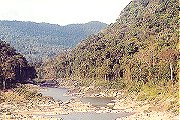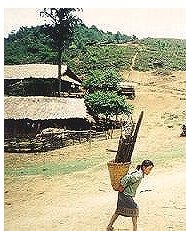

Laos 
 |
Wood Energy Situation Policies and Programmes Wood Energy Data Further Reading RWEDP Focal Points |
Wood Energy Situation
In Laos, fuelwood and electricity are the only energy sources produced locally. All petroleum products are imported. The production of electricity from hydro-power is substantial but most of it is exported to Thailand. Wood energy is the main source of energy and accounted for 89% of the country`s total energy consumption in 1994. Almost 93% of all households use woodfuels as their primary source of energy for cooking. Almost all rural households use woodfuels for cooking, while about 68% of urban households do.
Forests are the main source of woodfuel, supplying an estimated 85% of all fuelwood. Baseline data is still lacking. The country is increasingly facing wood energy problems, for which little or no provisions have yet been made. The problems are being recognised by the government. RWEDP suggested to the Committee for Planning and Co-operation, which directs the Statistical Office, that it include questions on (wood) energy in the national census of March 1995. This materialised with a question regarding the main sources of energy for cooking. The census results show that wood in rural areas accounts for 98-99% of total cooking and heating energy consumption.
Policies and Programmes
Forestry officials believe shifting cultivation to be the main cause of deforestation, though systematic evidence is still lacking. It is not known to what extent (illegal) logging would be a major cause. National planning capabilities with regard to wood energy and related problems are still limited. A Country Status Paper on Forestry Sector Planning has been prepared by the Planning Division of the Department of Forestry (DOF).
 DOF has a Social Forestry Support Unit which is involved in allocating land for village wood lots. Individual farmers are also given land to grow fuelwood. Furthermore, rural industries are encouraged to grow their own fuelwood and they receive land for this purpose. Research on fast-growing species is undertaken at DOF's Silviculture Centre. Furthermore, DOF is building up a pilot extension network in seven districts (out of a total of 110) in seven provinces (out of a total of 16).
DOF has a Social Forestry Support Unit which is involved in allocating land for village wood lots. Individual farmers are also given land to grow fuelwood. Furthermore, rural industries are encouraged to grow their own fuelwood and they receive land for this purpose. Research on fast-growing species is undertaken at DOF's Silviculture Centre. Furthermore, DOF is building up a pilot extension network in seven districts (out of a total of 110) in seven provinces (out of a total of 16).
The longstanding Lao-Swedish Forestry Co-operation Programme provides institutional support to DOF. Stoves for cooking (tripods) and space heating are the major woodfuel activities, in addition to small-scale industries. Some limited programmes are in place for improved cookstoves, for which RWEDP has provided assistance. Programmes for improved stoves are thought to be greatly needed.
Several programmes are being undertaken in Lao PDR with international support from Swedish International Development Cooperation, and World Bank concerning environment and sustainability. A private sector organisation is active in agroforestry and rural development.
Wood Energy Data
| General | |||||
| Population (1996) | 5 mln. | ||||
| Share of Rural Population | 77.6% | ||||
| GDP per capita (1995) in constant 1987 US$ | 363 | ||||
| Energy Consumption (1995) | |||||
| Total Final Energy Consumption in PJ | 44.8 | ||||
| Consumption of Wood Energy in PJ | 34.6 | (77.3%) | |||
| Consumption of Biomass Energy in PJ | 34.6 | (77.3%) | |||
| Wood Energy Resources | |||||
| Forest Area (1995) in 1000 ha | 12,435 | (53.9%) | |||
| Natural Forest Area (1995) in 1000 ha | 12,431 | (53.9%) | |||
| Agricultural Area in (1994) 1000 ha | 1,650 | (7.1%) | |||
| Share of Woodfuels from Forest Areas | NA | ||||
| Potential Wood Energy Supply (1994) | |||||
| Sust. Supply from Natural Forest in kton | 18,446 | ||||
| Sust. Supply from Forest Plantations in kton | 26 | ||||
| Sust. Supply from Agriculture Areas in kton | 979 | ||||
| Sust. Supply from Other Wooded Land in kton | 4,788 | ||||
| Supply from Wood Waste from Deforestation in kton | 21,767 | ||||
| Total Potential Supply in kton | 46,006 | ||||
| Primary Wood Energy Requirements in kton | 2,329 | ||||
Notes:
Population and land use data from FAO (FAOSTAT), GDP per capita from World Bank. Energy consumption data from various sources.
Potential wood energy supply estimated by RWEDP, based on available data for land use, wood productivity and estimates on availability of wood for energy use. For forest land, other wooded land and agriculture areas, the potential supply is based on average annual yield estimates, assuming a sustainable use of resources (Sust.: sustainable). Wood waste from deforestation refers to wood potentially available from natural forest land cleared due to commercial logging, expansion of agriculture land or other reasons. The estimates are based on aggregated national data, which can hide local variations, ranging from scarcity to abundance. For detailed calculations and estimates for 2010, see FD50, chapter 8
Further reading:
| Regional Study on Wood Energy Today and Tomorrow in Asia, Field Document 50, 1997 | |
| Chapter 2 in Review of Wood Energy Data in RWEDP Member Countries, Field Document 47, 1997 |
Focal points are the main contacts for RWEDP in a member country. Generally, in each country, there is one focal point in the energy sector, and one in the forestry sector.
| Director General Department of Forestry Ministry of Agriculture and Forestry PO Box 2932, Vientiane TEL: 856-21-215000/215005 FAX: 856-21-215004 |
Comments, questions? webmaster@rwedp.org
© FAO-RWEDP, 1999